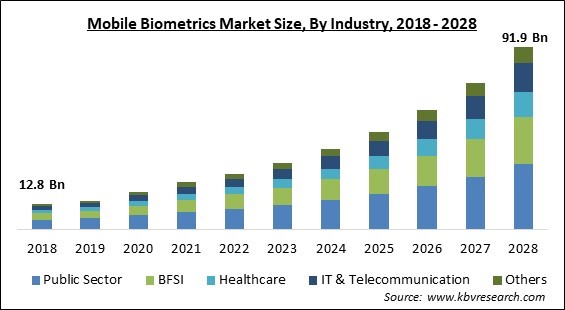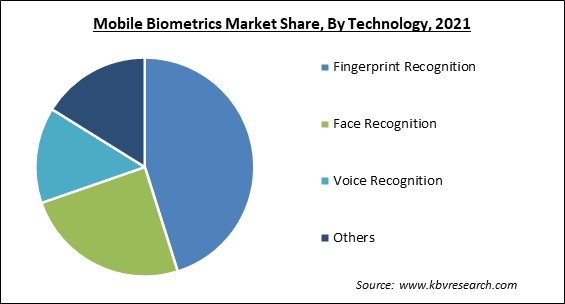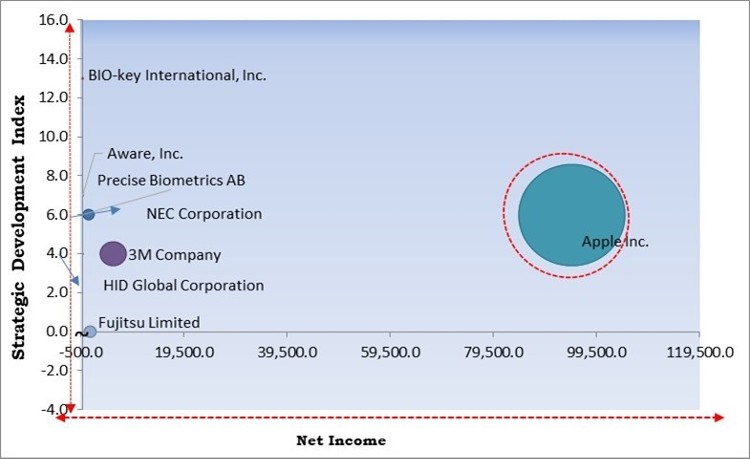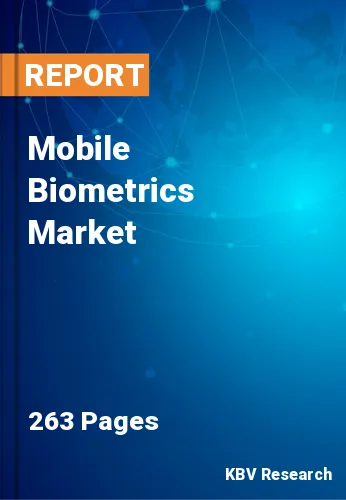The Global Mobile Biometrics Market size is expected to reach $91.9 billion by 2028, rising at a market growth of 21.8% CAGR during the forecast period.
Mobile biometric authentication uses biometrics to recognize and confirm a person's identity when they attempt to access any mobile application. Authentication can be carried out using these mobile biometric devices in a number of different ways, including face recognition, fingerprint readers, voice recognition, and others. Mobile biometrics solutions straddle the line between identity and connectivity.

They make use of smartphones, tablets, other forms of handheld devices, wearable technologies, and Internet of Things devices for their flexible deployment capabilities. Controlling access to information, locations, and systems have become more and more necessary over time. Many businesses currently use cards, PINs, or passwords to verify users' identities before granting access. However, there are significant problems with this conventional method.
In recent years, biometric technology has gained popularity on mobile devices. The technology improved in terms of user-friendliness and consumer affordability. This biometric solution is a method used to authenticate a person who is in possession of a mobile device and uses it as a distinctive biometric identifier. Single-factor authentication (SFA) and multi-factor authentication (MFA) are the two different authentication mechanisms used by mobile biometric systems.
These systems operate using a variety of techniques, including Deep Neural Networks and Keystroke Dynamics. Together, these procedures form a mobile biometrics system that provides coordinated security for mobile devices. The demand for this effective security solution typically increases significantly. In order to determine similarity, biometric authentication compares data for a person's features to that person's biometric "template".
The pandemic had a positive impact on the mobile biometrics market. This was due to a significant shift toward the rise of digital stores and e-commerce platforms, which has led to an increase in the use of online payments. The potential for an increase in cyberattacks in the form of fraud and identity theft also guided the market. Secure authentication services for different banking and financial applications, like client KYC and money transfer, are required in such a situation, and the usage of top-notch security tools is crucial.
The demand for biometric solutions has increased over the past few years as digital media and internet content delivery have grown. Traditional methods of authentication, like signatures and text-based credentials, have been shown to be more difficult for users to use because they are so vulnerable to contemporary cyberattacks. Furthermore, customers really need to develop faster methods of authentication due to the growing quantity of digital services.
One of the key factors propelling the growth of mobile biometrics is the increasing demand for intelligence security devices in mobile devices to secure the data saved in the devices, such as bank account information, photos, recordings, contacts, and other personalized data. By confirming a physical, real-world characteristic that is (typically) specific to that person, such as fingerprints, facial features, voice articulation, and others, biometric solutions can give providers a higher level of assurance that the person is real.
False positives and inaccuracy are two of the most significant challenges. Biometric authentication procedures rely on insufficient data to confirm a user's identity. For instance, during the enrollment step, a mobile biometric device will scan a whole fingerprint and turn it into data. Future fingerprint biometric authentication, however, will only require a portion of the print to confirm identity, making the process speedier overall.
Based on the component, the mobile biometrics market is segmented into hardware, software and service. The hardware segment garnered the highest revenue share in the mobile biometrics market in 2021. This is caused by the fact that the majority of mobile devices include voice, fingerprint, or facial recognition technologies. Most mobiles in the mediocre range now come with a fingerprint recognition feature at the very least. During the coming years, this segment is likely to have a significant impact on the growth of the mobile biometrics market.

On the basis of authentication mode, the mobile biometrics market is bifurcated into single factor authentication and multi factor authentication. The multi-factor authentication segment witnessed a substantial revenue share in the mobile biometrics market in 2021. Multi-factor authentication requires the user to provide more than two verification factors. It allows them access to resources including applications, online accounts, and VPNs. MFA is a key component of a solid identity and access management (IAM) policy.
Based on technology, the mobile biometrics market is divided into fingerprint recognition, voice recognition, face recognition, and others. The fingerprint recognition segment garnered the maximum revenue share in the mobile biometrics market in 2021. The most used biometric identification method up until recently was fingerprinting. Because there are low-cost mobile devices with fingerprint biometrics available, most consumers worldwide can afford them.
On the basis of industry, the mobile biometrics market is categorized into public sector, BFSI, healthcare, IT & telecommunication, and others. The BFSI segment witnessed a substantial revenue share in the mobile biometrics market in 2021. With the development of technology, one of the key biometric developments in online banking is the usage of mobile biometric data. As more people use banking and financial services via online portals, there is a growing need for sophisticated authentication to safeguard the sensitive information of customers connected to the banking institution.
| Report Attribute | Details |
|---|---|
| Market size value in 2021 | USD 23.7 Billion |
| Market size forecast in 2028 | USD 91.9 Billion |
| Base Year | 2021 |
| Historical Period | 2018 to 2020 |
| Forecast Period | 2022 to 2028 |
| Revenue Growth Rate | CAGR of 21.8% from 2022 to 2028 |
| Number of Pages | 263 |
| Number of Tables | 462 |
| Report coverage | Market Trends, Revenue Estimation and Forecast, Segmentation Analysis, Regional and Country Breakdown, Competitive Landscape, Companies Strategic Developments, Company Profiling |
| Segments covered | Industry, Technology, Authentication Mode, Component, Region |
| Country scope | US, Canada, Mexico, Germany, UK, France, Russia, Spain, Italy, China, Japan, India, South Korea, Singapore, Malaysia, Brazil, Argentina, UAE, Saudi Arabia, South Africa, Nigeria |
| Growth Drivers |
|
| Restraints |
|
Based on region, the mobile biometrics market is analyzed across North America, Europe, Asia Pacific, and LAMEA. The North America region acquired the largest revenue share in the mobile biometrics market in 2021. This is due to the region's high concentration of companies offering mobile biometric solutions, which is projected to propel the market for this technology.
Free Valuable Insights: Global Mobile Biometrics Market size to reach USD 91.9 Billion by 2028

The major strategies followed by the market participants are Acquisitions. Based on the Analysis presented in the Cardinal matrix; Apple, Inc. is the forerunner in the Mobile Biometrics Market. Companies such as 3M Company, BIO-key International, Inc., Aware, Inc. are some of the key innovators in Mobile Biometrics Market.
The market research report covers the analysis of key stake holders of the market. Key companies profiled in the report include 3M Company, Apple Inc., NEC Corporation, BIO-key International, Inc., Fujitsu Limited, HID Global Corporation, Precise Biometrics AB, M2SYS Technology, Inc., and Aware, Inc.
By Industry
By Technology
By Authentication Mode
By Component
By Geography
The Mobile Biometrics Market size is projected to reach USD 91.9 billion by 2028.
Increase In Platforms Using Biometric Authentication are driving the market in coming years, however, Wrong And Inaccurate Results Through Biometrics restraints the growth of the market.
3M Company, Apple Inc., NEC Corporation, BIO-key International, Inc., Fujitsu Limited, HID Global Corporation, Precise Biometrics AB, M2SYS Technology, Inc., and Aware, Inc.
The expected CAGR of the Mobile Biometrics Market is 21.8% from 2022 to 2028.
The Public Sector segment acquired maximum revenue share in the Global Mobile Biometrics Market by Industry in 2021 thereby, achieving a market value of $32.9 billion by 2028.
The North America market dominated the Global Mobile Biometrics Market by Region in 2021, and would continue to be a dominant market till 2028; thereby, achieving a market value of $33.7 billion by 2028.
Our team of dedicated experts can provide you with attractive expansion opportunities for your business.

